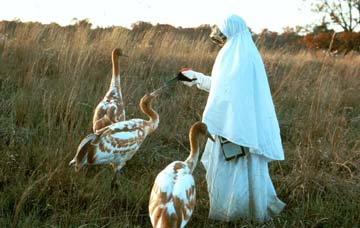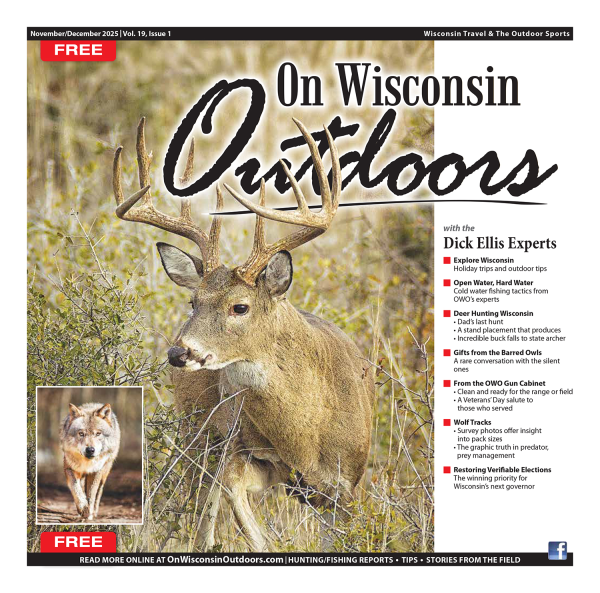Whooping crane chicks to be released to the wild later this week
Wisconsin DNR Weekly News – October 23, 2012
Second set of six checks to start their first migration
EDITOR'S NOTE: Davin Lopez, DNR’s whooping crane coordinator, and Joan Garland, International Crane Foundation outreach coordinator, will be on The Larry Meiller Show live on Wisconsin Public Radio from 11-11:45 Oct. 31 on these WPR Ideas Network stations or online. If you miss the show, you can still listen to the archives (all links exit DNR).
HORICON – Six whooping crane chicks are expected to be released into the wild later this week at Horicon National Wildlife Refuge with the hope they’ll fall in with an adult crane and start their first migration to Florida.
“One of our birds from last year is still at Horicon, so we’re hoping that by releasing the chicks in the same general area that they’ll be able to hook up with her and learn the migration route,” says Marianne Wellington, chick rearing supervisor for the International Crane Foundation, one of nine organizations in a partnership to establish an eastern flock of migratory whooping cranes.
First migration is one of many critical life stages for the birds, which are reared in captivity by people wearing costumes that resemble cranes, and for the partners’ efforts to build the flock. Whooping cranes have an instinctive urge to migrate but they learn when and where to go from their parents.
Six other young whoopers from Wisconsin took off Sept. 27 behind an ultralight plane and are making slow progress southward. The birds typically fly 20 to 30 miles a day when weather allows but they have been grounded on more days than not in Illinois by inclement weather or poor flying conditions, according to Davin Lopez, DNR’s whooping crane coordinator.
The two methods of releasing the birds and teaching them the routes – conditioning them to follow behind an ultra-light and directly releasing young birds as a group to follow adult whooping cranes or sandhill cranes headed south -- are being used now to increase the odds that crane chicks will successfully learn the migration routes and behave like wild birds, Lopez says.

Young whooping cranes raised by costumed “foster parents” will be released soon at Horicon in hopes they will follow adult whooping or sandhill cranes and make their first migration south.
“There are certain advantages of each method that for now remain important to helping the program be successful,” he says.
Since 1999, Wisconsin has played a major role in efforts to restore a migratory whooping crane population in eastern North America. DNR is a founding member of the Whooping Crane Eastern Partnership and the summer breeding area is in Wisconsin. The state’s role in helping restore this federally endangered species to North America is highlighted as part of DNR’s year-long feature on the 40th anniversary of the state’s endangered species law.
Before these efforts to establish a flock in the eastern U.S. began, only one migratory population of whooping cranes existed in the wild, raising concerns that any catastrophic event could have completely eliminated the species. That remaining flock, which wintered on the Gulf coast of Texas and migrated north in spring to Canada, had dropped to 16 birds in the 1940s.
Wildlife officials consider establishing the eastern flock a cutting-edge species recovery project; one U.S. Fish and Wildlife Service official described it as "the wildlife equivalent of putting a man on the moon," according to Come on whoopers!, an article in the October 2012 Wisconsin Natural Resources magazine.
Lopez says that the eastern migratory flock is growing but that nesting success and survival of chicks is not as strong as the partners originally hoped. The population is 104 birds, not counting the six birds following the ultralight or the six that will be released later this week; both groups are not considered released yet.
The flock has produced chicks at Necedah in recent years, but whooper parents have abandoned many of their nests there before the eggs hatch. One theory is that black flies have been a problem and have been chasing the parents off the nests, Lopez says.
To better understand why parents were abandoning nests and to develop another nesting site, the partners in 2011 started releasing young birds in DNR’s White River Marsh Wildlife Area in Green Lake County and at Horicon National Wildlife Refuge in Dodge County. They also started experimental black fly control efforts at Necedah.
In 2012, nesting and hatching success improved – there was a record nine chicks hatched in the wild – but only two of those chicks survived. Partners are unsure what happened to the chicks, but believe they were likely killed by predators, Lopez says.
Next year, partners won’t treat for black flies at Necedah as part of continuing research into understanding the factors determining nesting success. “If black flies are the reason behind low nesting success, then next year, when we don’t treat, we’d expect to see nest abandonment go up,” he says. “If it’s that the birds are getting older and more experienced, we’d expect nesting success to continue to go up even without the black fly treatment.”
Wellington says that partners have learned a lot about whooping cranes and raising them, and are still learning more. For instance, research involving the direct release birds seeks to determine “when they set their GPS that this spot is their home,” she says.
The chicks Wellington and her three interns work with were hatched at the International Crane Foundation near Baraboo and were reared there until they were 5 to 7 weeks old, at which time they were moved to Necedah and raised there in a semi-captive state. Once the birds start to begin flying, they are moved to Horicon where they are kept in pens that are protected from predators but allow the birds to fly out and start getting acclimated to that kind of habitat.
Wellington and partners are also trying to understand how quickly chicks can gain from human “foster” parents the skills they need so that time with the humans can be reduced to just what’s necessary. “They learn a lot from their parents, so we’re trying to find what they need to learn before they are released. They mimic what we do, so the less time we spend with them, the less time we have to change them,” she says.
FOR MORE INFORMATION CONTACT: Davin Lopez (608) 266-0837; Joan Garland, International Crane Foundation, 608-381-1262











